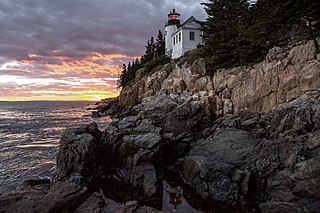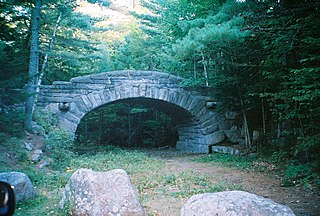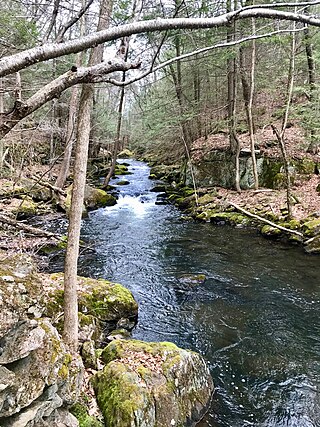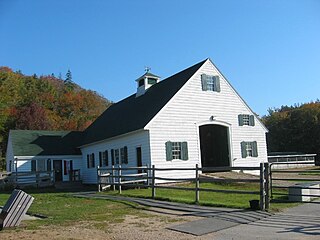
Rock Creek Park is a large urban park that bisects the Northwest quadrant of Washington, D.C. Created by Act of Congress in 1890, the park comprises 1,754 acres, generally along Rock Creek, a tributary of the Potomac River.

The National Road was the first major improved highway in the United States built by the federal government. Built between 1811 and 1837, the 620-mile (1,000 km) road connected the Potomac and Ohio Rivers and was a main transport path to the West for thousands of settlers. When improved in the 1830s, it became the second U.S. road surfaced with the macadam process pioneered by Scotsman John Loudon McAdam.

Acadia National Park is an American national park located along the mid-section of the Maine coast, southwest of Bar Harbor. The park preserves about half of Mount Desert Island, part of the Isle au Haut, the tip of the Schoodic Peninsula, and portions of 16 smaller outlying islands. It protects the natural beauty of the rocky headlands, including the highest mountains along the Atlantic coast. Acadia boasts a glaciated coastal and island landscape, an abundance of habitats, a high level of biodiversity, clean air and water, and a rich cultural heritage.

Cape Breton Highlands National Park is a Canadian national park on northern Cape Breton Island in Nova Scotia. The park was the first national park in the Atlantic provinces of Canada and covers an area of 948 square kilometres (366 sq mi). It is one of 42 in Canada's system of national parks.

Bar Harbor is a resort town on Mount Desert Island in Hancock County, Maine, United States. As of the 2020 census, its population is 5,089. The town is home to the College of the Atlantic, Jackson Laboratory, and MDI Biological Laboratory. During the summer and fall seasons, it is a popular tourist destination.

Mount Desert Island in Hancock County, Maine, is the largest island off the coast of Maine. With an area of 108 square miles (280 km2) it is the 52nd-largest island in the United States, the sixth-largest island in the contiguous United States, and the second-largest island on the Eastern Seaboard, behind Long Island and ahead of Martha's Vineyard. According to the 2010 census, the island has a year-round population of 10,615. In 2017, an estimated 3.5 million tourists visited Acadia National Park on MDI. The island is home to numerous well-known summer colonies such as Northeast Harbor and Bar Harbor.
A National Parkway is a designation for a protected area in the United States given to scenic roadways with a protected corridor of surrounding parkland. National Parkways often connect cultural or historic sites. The U.S. National Park Service manages the parkways.

U.S. Route 101 (US 101), is a major north–south U.S. Highway in Oregon that runs through the state along the western Oregon coastline near the Pacific Ocean. It runs from the California border, south of Brookings, to the Washington state line on the Columbia River, between Astoria, Oregon, and Megler, Washington.

Oxon Creek is a stream on the Potomac River which feeds a cove that straddles the border between Washington, D.C., and Prince George's County, Maryland just north of Interstate 495 at Woodrow Wilson Bridge. Oxon Creek heads at the confluence of Oxon Run and Barnaby Run, sometimes referred to as Winkle Doodle Run. It starts just inside the boundary of D.C. and then runs 1.5 miles (2.4 km) to the south and west into Maryland to empty into the Potomac at Goose Island across from the city of Alexandria, Virginia. Before reaching the Potomac, the creek widens to form Oxon Cove which is partially in Maryland and partially in Washington, D.C. The creek is almost entirely within Oxon Cove National Park, except for the first few feet in D.C. and a portion of the cove on the southside of the Blue Plains Advanced Wastewater Treatment Plant.

Acadia National Park, largely on Mount Desert Island, off the coast of the U.S. state of Maine, was created in part by land and other donations by John D. Rockefeller Jr. Between 1919 and 1931, Rockefeller, who was opposed to the introduction of automobiles on the island, personally oversaw the construction of a network of carriage roads, closed to motorized vehicles, on the eastern half of the island, including sixteen granite bridges and two gatehouses. The major portion of this network now falls within the bounds of the national park, and was listed on the National Register of Historic Places in 1979.

Goffle Brook Park is a public, county park spanning much of the length of Goffle Brook through the borough of Hawthorne in Passaic County, New Jersey, United States. Since its designation and construction between 1930 and 1932, the park has served to protect the waters of Goffle Brook while at the same time providing recreational opportunities to the residents of Passaic County and nearby Bergen County. Goffle Brook Park has been included in the National Register of Historic Places since 2002.

The Pequonnock River is a 16.7-mile-long (26.9 km) waterway in eastern Fairfield County, Connecticut. Its watershed is located in five communities, with the majority of it located within Monroe, Trumbull, and Bridgeport. The river has a penchant for flooding, particularly in spring since the removal of a retention dam in Trumbull in the 1950s. There seems to be a sharp difference of opinion among historians as to just what the Indian word Pequonnock signifies. Some insist it meant cleared field or open ground; others are sure it meant broken ground; while a third group is certain it meant place of slaughter or place of destruction.

The 'Hancock Brook Trail' is a 2.8-mile (4.5 km) Blue-Blazed hiking trail Waterville Section of the City of Waterbury in New Haven County close to the borders of Thomaston and Plymouth, Litchfield County, Connecticut. It is contained overwhelmingly in a section of the Mattatuck State Forest bounded by Hancock Brook on the east, Thomaston Avenue on the west and Spruce Brook Road / Route 262 to the north.

George Bucknam Dorr was an American preservationist. Known as the "father of Acadia National Park," he spent most of his adult life overseeing the park's formation and expansion.

Joseph Paul Skelly, also abbreviated J. P. Skelley, was a composer of music. He arranged the music for songs published as sheet music. For other songs he composed the words and music. The Lester S. Levy Sheet Music Collection at Johns Hopkins University has sheet music for many of the songs he composed. The Library of Congress has several of his works in its collection.
Jordan Stream is a watercourse, about 1.4 miles (2.3 km) long, in the American village of Seal Harbor, Maine. It originates at the southern end of Jordan Pond, in the nearby town of Mount Desert, and flows directly south to its mouth at the northern end of Little Long Pond.
Duncan Willson Candler was an American architect known for his various projects for Abby and John D. Rockefeller Jr. and the house Skylands for Edsel Ford. Martha Stewart says Candler is "a genius who deserves a book."

Park Loop Road is a scenic road through part of Acadia National Park in Maine, United States. 27 miles (43 km) long, it traverses the eastern side of Mount Desert Island in a (mostly) one-way, clockwise direction, from Bar Harbor to Seal Harbor. The road is two-way for a section between Wildwood Stables, toward the middle of Mount Desert Island, and the Hulls Cove entrance near Bar Harbor. A toll is required for vehicles continuing on the Loop Road beyond the entrance station immediately inland from Schooner Head overlook; the 5.3-mile (8.5 km) section between Paradise Hill Road, at the foot of Cadillac Mountain, and the entrance station is toll-free.

Wildwood Stables is a farm near Seal Harbor on Mount Desert Island, Maine, United States. Located in Acadia National Park, on the Park Loop Road, the farm was established in 1911. Only the original barn is now standing, after the National Park Service demolished the farm's other structures in 1958. Today, Wildwood Stables is home to several horses which pull carriages around the park's carriage trails in the spring, summer and fall months.


















